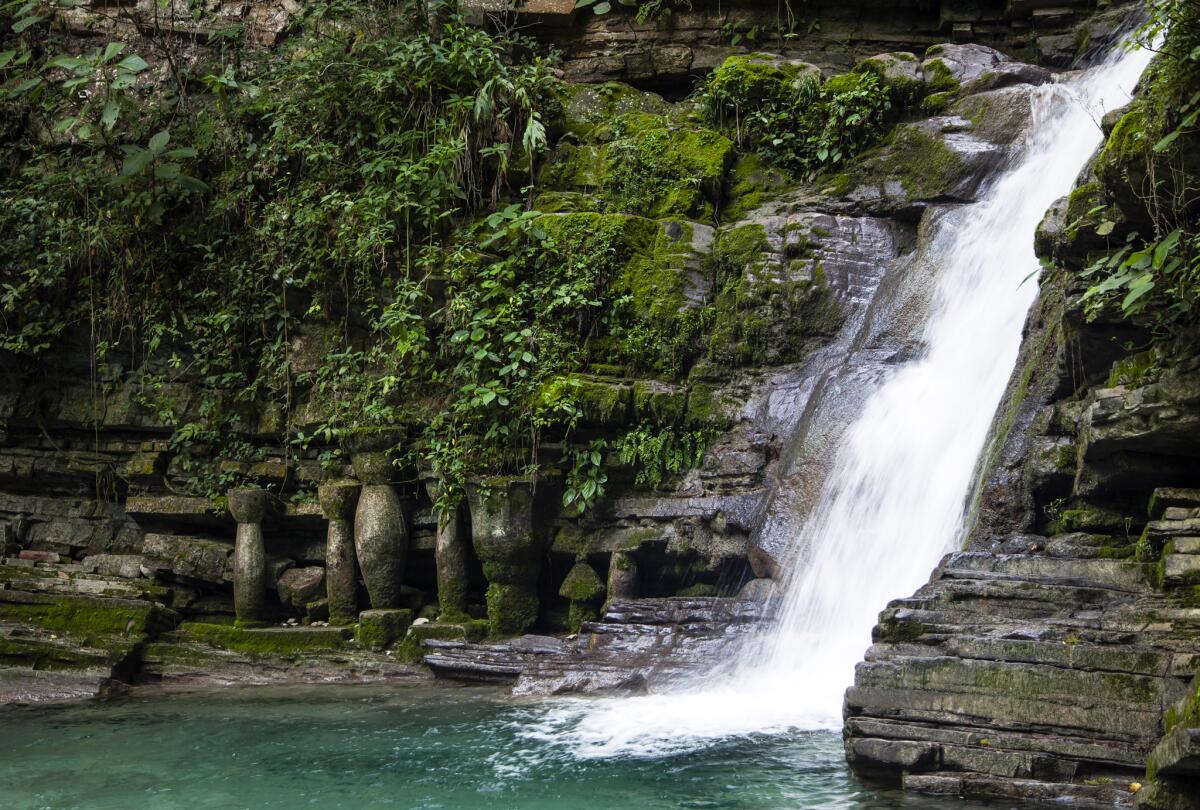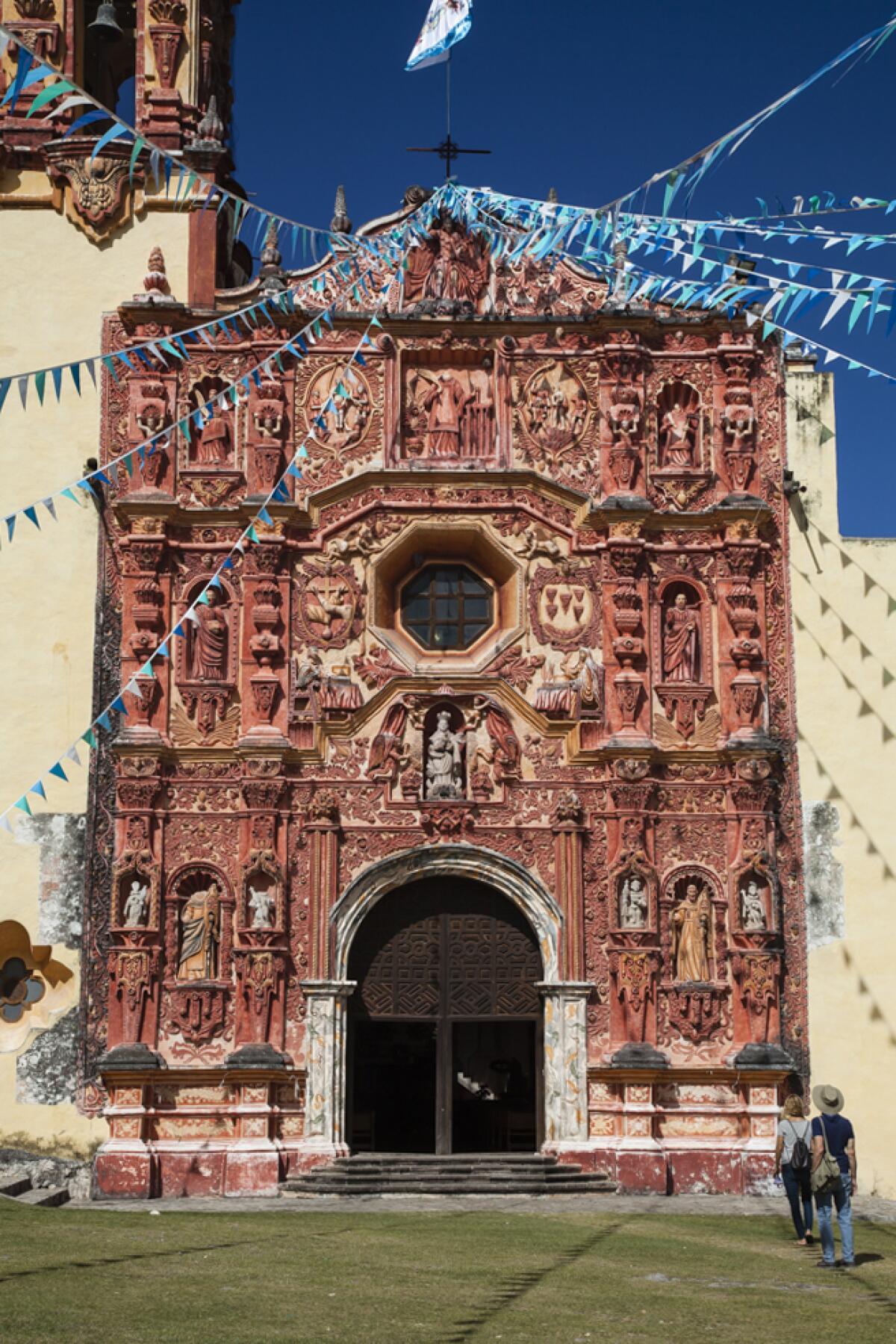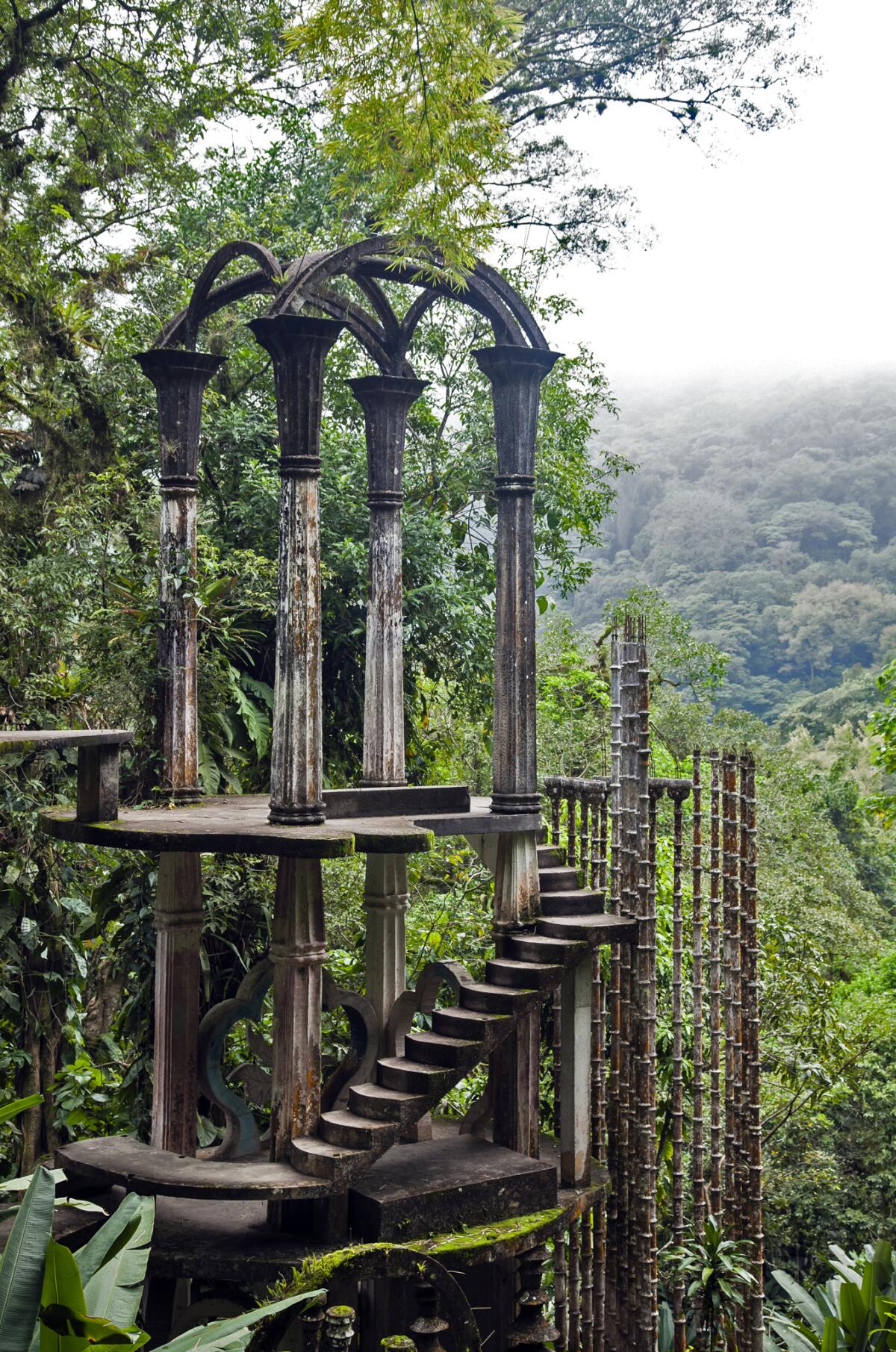A road trip to Mexico’s secret, surreal jungle garden

- Share via
XILITLA, Mexico — I had forgotten what fun a road trip could be.
My wife, Ann, and I live part of the year in San Miguel de Allende, one of Mexico’s top destinations, so in November when friends from L.A. suggested going to Las Pozas, a surrealistic garden in the state of San Luis Potosí, we jumped at the chance to get out of town and become tourists.
After all, they had a rental car and would be driving.
We planned to spend half of the first day in Bernal and then two nights in Xilitla, where poet Edward James built his madcap garden. That would give us a full day there before the drive back.
Peak experience
Bernal is an hour’s drive southeast of San Miguel, an easy day trip, but at least four hours from Mexico City, depending on traffic. It’s known for its sweets, weavings and opals.
The main attraction is La Peña, the Peak, a solid rock formed by volcanic eruption and said to be the world’s tallest monolith. It towers 1,200 feet above the 400-year-old town. It is taller than but similar to better-known formations such as the Rock of Gibraltar and Sugarloaf in Rio de Janeiro.
The Otomí and Chichimecan peoples regarded La Peña as a source of natural power, a primal energy. The topographical marker is visible for miles, a jutting anomaly on the horizon that draws the eye.
At the spring equinox — March 19 this year — tens of thousands of visitors take a dawn walk up the trails to the peak. Many dress in white adorned with bright red accessories. Some come to recargar — recharge — on the day when the forces of darkness and light are equally balanced.
That was what the waiter told us at Mesquite restaurant — “best view of La Peña!” said the sign out front — where we had lemonade and guacamole. The view from the open terrace was indeed spectacular but breezy and cold, so we went shopping.
Shops throughout the small centro were selling hand-woven blankets, rugs, scarves, serapes, caps and vests. Weavers use a blend of locally produced and imported wools. Prices were about half what they would be in San Miguel.
On Calle de Artesanías we talked to weaver David Adame, who proudly showed us his wool spinner that his parents had made out of a recycled bicycle rim. He had made his own loom.
“I had to make it myself so I know how it works,” he said. “I use it every day.”
Sharp ravines and sinkholes
Back in the car we headed east, following Mexico 100, a hair-raising two-lane road with lots of switchbacks that rises into the Sierra Gorda Biosphere Reserve. As we looked back, we could see the distinctive silhouette of La Peña in the haze.
The Sierra Gorda is filled with sharp ravines, caves and sinkholes. The angled range catches rain from the Gulf of Mexico, and microclimates abound. Coffee and vanilla are grown here, and the rain forests have parrots and jaguars.
Highway 100 merges into Highway 120 and continues to Xilitla and the coast, climbing to nearly 8,000 feet at the small town of Pinal de Amoles, the highest point on the road.

Adventurers jump off here to explore the Río Escanela and the Bridge of God and Canyon of Narrowness, two of the biosphere’s natural highlights where emerald-colored pools and warm rivers flow through stalactite-curtained caves.
We blew past, preferring to stop at Jalpan de Serra. The church Junípero Serra built here on the main square was his first and is considered the highlight of the five Franciscan missions in the Huasteca, collectively a UNESCO World Heritage Site.
The facades of the missions are nothing like the staid designs of those Serra later built in Alta California. They are a blend of Franciscan and indigenous motifs: a robe-clad friar being pulled by divine rays to God, mermaids with Olmec features, jaguars next to angels.
Surrealist garden
We arrived in Xilitla at twilight and checked in to Posada el Castillo, James’ former home in the centro. It was a bit musty but contained a museum about Las Pozas that included concrete forms used in building the garden as well as poems, drawings, letters and paintings.
James was a surrealist patron, writer and rumored illegitimate son of the Prince of Wales (Edward VII). He came to the village of Xilitla in 1945 searching for orchids. He was burned out from hanging with other Brits in Hollywood and wanted to create a Garden of Eden in Mexico.
He bought 80 acres of land in a ravine where waterfalls cascaded year-round into a series of natural pools that gave the place its name, Las Pozas, or “the Pools.” It would be an ideal place for an orchid farm.
With partner Plutarco Gastélum, James collected tens of thousands of plants. When a cold snap in 1962 killed many of them, the two began to build a garden that frost couldn’t kill, using poured concrete in do-it-yourself forms. They built 40 structures, some useful, some whimsical, around the garden.
Las Pozas, more sculpture garden than architectural test lab, shows James’ surrealist vision and expansive bankroll. It cost him $5 million over decades, funds raised by selling many of the Salvador Dalí and René Magritte paintings he had bought when the artists were young and struggling, and they were all great friends.
The next day we drove to Las Pozas, where a busload of architectural students was waiting at the entrance. The garden is one of Mexico’s must-sees for anyone interested in what you can do with enough cement and no permits.

We took the Road of the Seven Deadly Sins, bypassing the oval-screened Cinema, toward the spiral Stairway to Nothing and the Bamboo Palace, where a grove of cement bamboo shuddered slightly in the breeze.
We could see the House With a Roof Like a Whale; the Sarcophagus, where James would meditate among the bromeliads; and the bathtub shaped like an eye. We traipsed around the ravine and down to the pools where he and Gastélum would bathe, concrete gorilla-size footsteps showing the way.
For our second night we stayed at Hotel Campestre Paraíso Encantado, a small accommodation run by Gastélum’s granddaughters just down the dirt road from Las Pozas.
The next morning we had a dip in the pool, a short revisit to Las Pozas for more pictures, and then back in the car for the six-hour drive home. The weekend was over. Tourists no more.
If you go
From LAX, United, American, Aeromexico and Delta offer connecting service (change of planes) to Querétaro, Mexico, the nearest airport. Restricted round-trip airfare from $350, including taxes and fees.
WHERE TO STAY
Casa Tsaya Hotel Boutique, 9 Ignacio Zaragoza, Zona Centro, Bernal, Mexico; 011-52-441-296-4001, casatsaya.com. Newish hotel with an excellent courtyard restaurant and a good view of La Peña. Doubles from $92 a night.
La Posada el Castillo, 105 Calle Melchor Ocampo, Xilitla, Mexico; 011-52-489-365-0038, elcastilloxilitla.com. Built by Plutarco Gastélum for his family as well as Edward James. It’s a concrete castle in the village and still run by Gastélum’s relatives. Doubles from $100 a night.
Hotel Campestre Paraíso Encantado, 10 Camino a las Pozas, La Conchita, Xilitla, Mexico; 011-52-489-100-7679. Also run by the Gastélum family, with its own restaurant and pool. Doubles from $65 a night.
WHERE TO EAT
Restaurante el Mezquite, 1 Iturbide, Zona Centro, Bernal, Mexico. One of the best views of La Peña. Gorditas a speciality, from $3.
Dätsö Restaurante, 6 Cinco de Mayo, Bernal, Mexico. Rooftop restaurant with a great view. Excellent coffee and pastries from the downstairs espresso bar.
WHAT TO DO
Las Pozas, 10 Camino a las Pozas, La Conchita, Xilitla, Mexico. laspozasxilitla.org.mx/en/index.html. Admission $6.
More to Read
Sign up for The Wild
We’ll help you find the best places to hike, bike and run, as well as the perfect silent spots for meditation and yoga.
You may occasionally receive promotional content from the Los Angeles Times.






